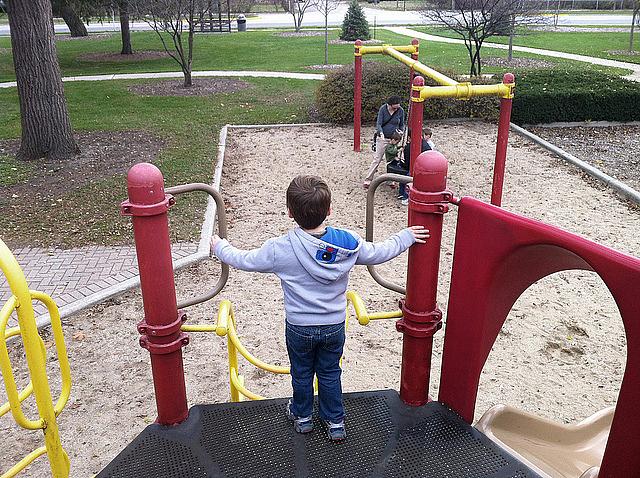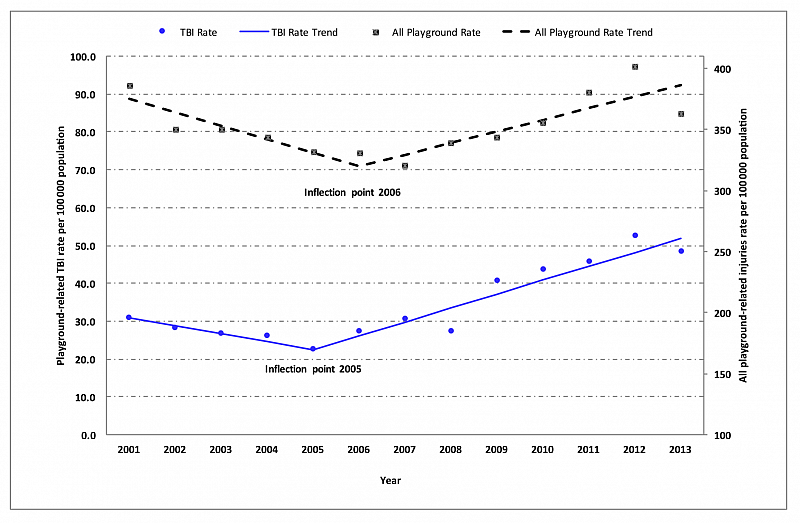Did that playground brain injury study really warrant this much coverage?

Is this child in grave danger? Some of this week's media coverage might lead you to think so.
Researchers at the Centers for Disease Control and Prevention released a study Monday that details trends in playground brain injuries from 2001 to 2013.
As you might’ve heard from the ample coverage the study received, the number of reported traumatic brain injuries (TBI) has risen in recent years. Cut to the shot of a kid dangling upside down from the monkey bars as Mom looks on worriedly.
Less noted, however, was the negligibility of the increase. Let’s take a quick tour of the numbers. The CDC study is based on a national sample of ER visits for playground-related injuries, and focuses on kids 14 and younger. For boys, the rate of ER visits for playground TBIs was about 40 per 100,000 kids over the study period. For girls, it was 29 per 100,000. The bottom line on this line graph shows how the numbers have changed over time:

As the trend line shows, playground TBIs went on average from about 30 per 100,000 in 2001 to around 50 per 100,000 in 2013. That’s enough for the study to conclude that the “annual rate of [traumatic brain injury] emergency department visits increased significantly from 2005 to 2013.”
But consider those same numbers put another way: The playground brain injury rate rose from 0.03 percent of kids to 0.05 percent of kids over the 13-year span. In terms of relative risk, that’s a 67 percent increase! But the change in absolute risk is negligible: The injury rate went from about 1 in 3,333 kids affected to 1 in 2,000 kids. (As health journalists, it’s never too soon for a refresher on the dangers of conflating relative and absolute risks.)
Not only is that an incredibly modest increase, but two other factors further downplay its real-world significance (very different from statistical significance):
1) The study notes that “[m]ost of these patients were treated and released, suggesting that they would likely be best categorized as mild in severity.” Nearly 96 percent of these kids were treated and sent home. In other words, the vast majority of kids were not seriously injured, despite the use of the scary-sounding “traumatic brain injury” term.
2) We’re not even sure if the reported increase in TBIs is the result of a slight uptick in playground injuries or simply heightened awareness among parents and doctors. Such “heightened awareness might lead health care providers to consider a TBI diagnosis after head injury,” the study notes.
With all that in mind, you might conclude this latest study is a bit of a non-story. And yet it garnered a flurry of coverage. “More Children Are Suffering Traumatic Brain Injuries at the Playground, Study Says,” ABC News tells us in a story entirely missing any numbers that would quantify the alleged uptick in risk. AP’s coverage does better on the numbers and caveats, but the lead is far less equivocal: “Playground concussions are on the rise, according to a new government study, and monkey bars and swings are most often involved.” That’s a problem, since often it’s only the headline, lead or Tweet that people read, with crucial nuance left to languish below the proverbial fold.
Amid all this questionable coverage, Dr. Claire McCarthy, a pediatrician at Boston Children’s Hospital, countered with some much-needed perspective on the Harvard Health Blog. While acknowledging the real threat posed by traumatic brain injuries, McCarthy goes on to suggest that there’s also a risk in rubberizing all the world’s hard edges. “[A]s a parent and pediatrician, I think we need to be careful with being careful.” She goes on:
So of course, let’s make our playgrounds safe. … But let’s not get overprotective in the process. Let’s not take down all the high climbing structures or big swings — and especially, let’s not stop our children from doing anything that might be risky. Because the risks will always be there — and we won’t always be there to watch them. It’s better they practice now, on a playground, with us nearby.
That’s not the kind of sane perspective that rises to the top of most media stories. Even when the story is handled well, with the numbers placed in their proper context, it doesn’t necessarily mean that coverage is warranted in the first place.
[Photo by Ryan Dickey via Flickr.]

